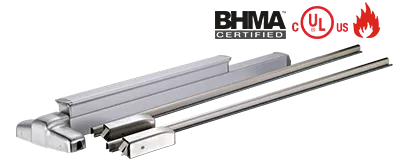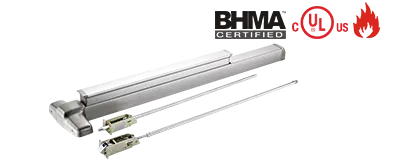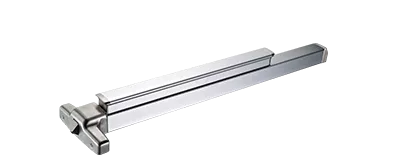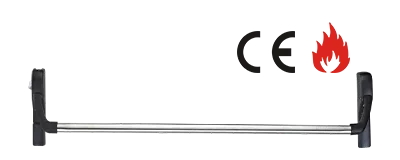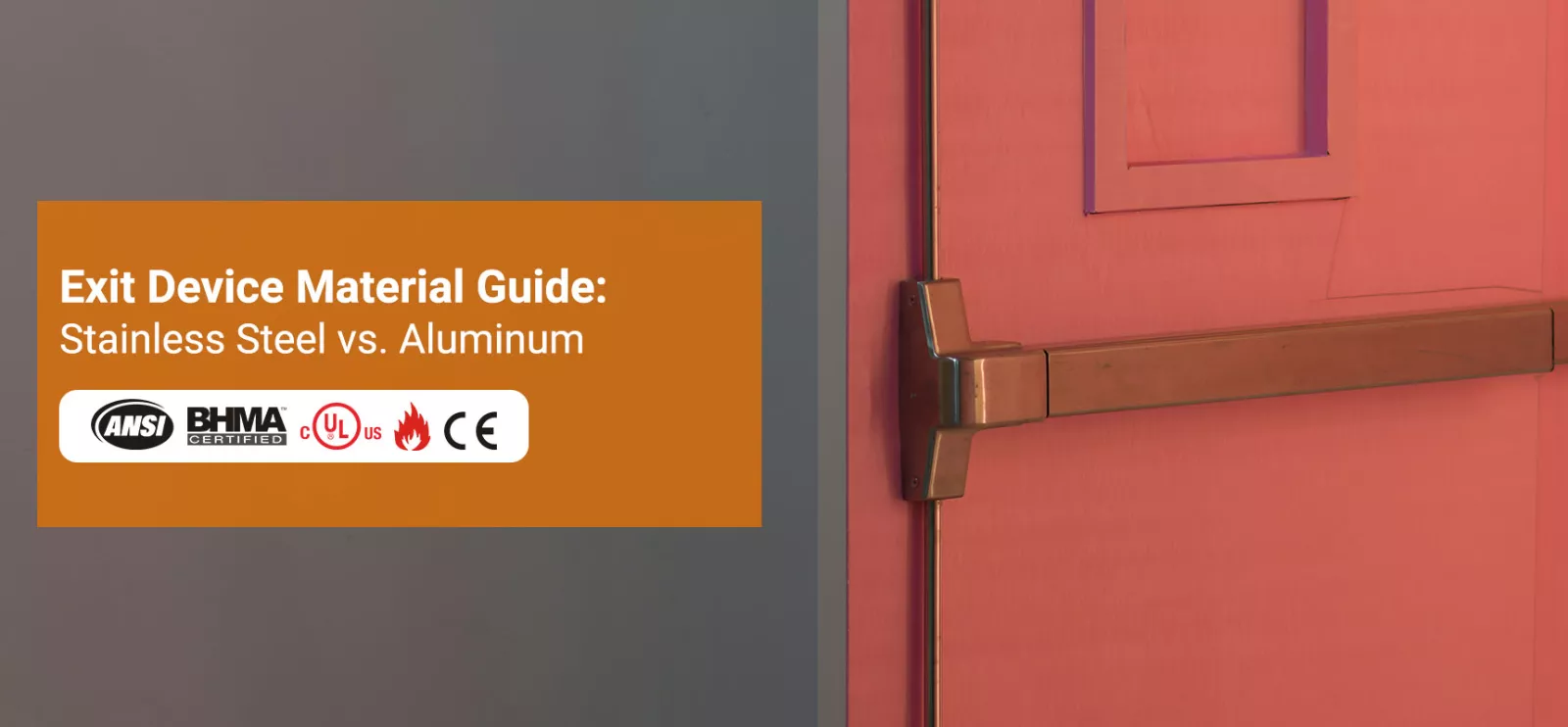
In the world of commercial building safety, choosing the right exit device material isn’t just a matter of durability. It is a decision that directly impacts emergency response, fire safety, and long-term reliability. Whether you're outfitting a high-traffic hospital, a seaside hotel, or a secure facility, selecting the appropriate material ensures your exit devices perform when it matters most.
This article breaks down the key materials used in modern exit devices—from stainless steel to aluminum—and examines how each one holds up under pressure, heat, corrosion, and certification tests. If you're looking to make smart, code-compliant choices about panic exit device material, this guide will walk you through everything you need to know.
Table of contents
How Do Different Exit Device Materials Impact Safety and Performance?
The material selection for exit devices goes far beyond simple cost considerations. Each material brings unique characteristics that directly impact performance, durability, maintenance requirements, and compliance with safety standards. Let's examine the most important options available in today's market.
1. Stainless Steel: The Premium Choice for Demanding Applications
Stainless steel exit device materials represent the gold standard in commercial hardware applications. This material stands out for its exceptional strength, unparalleled durability, and natural resistance to rust and corrosion. What makes stainless steel particularly valuable is its superior anti-microbial properties, making it the preferred choice for sterile environments such as hospitals, laboratories, and food processing facilities.
In terms of fire performance, stainless steel is hard to beat. Grade 304 stainless steel, widely used in panic and fire-rated devices, offers excellent resistance to extreme heat and retains its strength even under intense conditions. These devices are designed for longevity, capable of withstanding more than 500,000 usage cycles without compromising structural integrity, making them ideal for high-traffic and high-risk facilities.
Key Specifications for Stainless Steel Exit Devices:
Melting point: 1400-1450°C for 304 grade
Operational cycles: 500,000+ under demanding conditions
Certifications: UL 10C 3-Hour Fire Rated, ANSI A156.3 Grade 1
Corrosion resistance: Excellent in all environments
The applications for stainless steel are extensive. You'll find it in high-end commercial buildings, museums, hotels, airports, and specialized facilities like laboratories and subway systems. Its weather resistance makes it particularly suitable for exterior doors, while its ease of maintenance provides excellent long-term value compared to wood, aluminum, or fiberglass alternatives.
2. Aluminum: Lightweight Performance with Proven Reliability
Aluminum exit device materials are a popular choice in commercial settings thanks to their lightweight and durable nature. Their excellent strength-to-weight ratio and natural resistance to corrosion make them especially well-suited for buildings in coastal or high-humidity environments, where exposure to salt and moisture can quickly degrade other materials.
Although aluminum has a relatively low melting point of around 660.3°C, it performs surprisingly well under fire conditions. This is due to its exceptional thermal properties—aluminum has a high specific heat capacity, excellent thermal conductivity, and strong reflectivity. These qualities help it absorb and disperse heat efficiently, reducing the risk of rapid structural failure during a fire and making it a viable option for many fire-rated exit device material applications.
The key to aluminum's fire-rated exit device material performance lies not in withstanding extreme temperatures indefinitely, but in its ability to resist ignition, delay structural failure, and crucially, avoid contributing to fire spread through harmful gas emissions.
Aluminum is widely used in panic bars for everyday commercial applications, especially on narrow-stile aluminum doors often found in modern storefronts and sleek architectural designs. Its lightweight construction and ease of fabrication make it an excellent choice for environments with high humidity—such as swimming pool facilities or fitness centers—where its corrosion resistance offers long-term performance and minimal maintenance.
Material Impact on Testing and Certification Standards
Choosing the right commercial exit device material goes beyond aesthetics or cost—it plays a critical role in meeting building codes and passing rigorous safety certifications. Understanding how various materials perform under standardized testing is essential for ensuring your exit devices comply with fire, durability, and egress requirements, ultimately safeguarding both occupants and property.
1. ANSI/BHMA A156.3: The Foundation of Performance Standards
The American National Standards Institute (ANSI) and Builders Hardware Manufacturers Association (BHMA) establish comprehensive performance standards that directly correlate with material selection. ANSI/BHMA A156.3 categorizes exit devices into three performance grades, with material choice being a determining factor in achieving higher grades. Camax Hardware manufactures ANSI exit devices certified to ANSI/BHMA A156.3.
Grade 1: Heavy-duty commercial applications requiring materials like stainless steel for high-traffic buildings including hospitals, schools, and office complexes. These devices must withstand 1,000,000+ operational cycles.
Grade 2: Medium-duty applications where aluminum or high-quality zinc alloys provide adequate performance for moderate-traffic commercial buildings.
Grade 3: Light-duty applications suitable for engineered plastics or basic aluminum construction in low-traffic commercial or residential settings.
- • Heavy-Duty Panic Device
- • Non-handed
- • Certificate: ANSI/BHMA A156.3 grade 1; UL10C, 3-hour fire rated
- • Work with ANSI mortise locks.
- • Material: Stainless steel, Steel
- • Security anti-thrust latch.
- • CE & UL Listed Panic Touch Bar
- • Non-handed
- • Certificate: ANSI/BHMA A156.3 grade 1; UL10C, fire rated
- • Material: Stainless steel, Steel
- • Finish: Stainless steel satin, Silver painted, Polishing, PVD, Black, Red
2. UL Standards: Fire Safety and Material Performance
Underwriters Laboratories (UL) testing directly evaluates how different materials perform under fire conditions. UL 305 standards for panic hardware and UL 10C positive pressure fire tests create distinct requirements that favor certain materials over others.
Fire-rated exit device material selection becomes critical when devices must pass UL 10C testing to qualify as fire exit hardware rather than standard panic hardware. This distinction requires materials that maintain structural integrity under extreme heat while preventing fire spread.
- • Concealed Vertical Rod Exit Device
- • Non-handed
- • Certificate: ANSI/BHMA A156.3 grade 1; UL10C, fire rated
- • Material: Stainless steel, Steel, Aluminum
- • Finish: Stainless steel satin, Silver painted, Polishing, PVD, Black, Red
- • Narrow-Stile Door Exit Device
- • Non-handed
- • Compliance: ANSI/BHMA A156.3 grade 1; UL10C, 3-hour fire rating
- • Material: Stainless steel, Steel, Aluminum
- • Modular design, more than 4-point locks are available. Security anti-thrust latch.
3. EN1125: European Standards and Material Requirements
The European EN1125 certification sets strict material performance standards that significantly influence both the design and functionality of exit devices. One key requirement is corrosion resistance, which includes demanding salt spray tests lasting between 96 to 240 hours based on the durability classification. These tests make stainless steel—particularly grades 304 and 316—a preferred choice due to their proven ability to withstand harsh, moisture-rich environments.
EN1125 Material Performance Requirements:
Corrosion resistance: 96-240 hours salt spray testing
Force resistance: 1000N in four directions for 10 seconds
Temperature performance: -10°C to 60°C with less than 50% force variation
- • Narrow Stile Crossbar Exit Device
- • Handed
- • Certificate: EN1125, categoery 3; EN1634-1, 2-hour fire rated
- • Material: Stainless steel, Steel, Plastic
- • Finish: Stainless steel satin, Silver painted, Polishing, PVD, Black, Red
- • Concealed panic exit device
- • Non-handed
- • Certificate: EN1125; EN1634-1, fire-rated
- • Material: Stainless steel, Steel, Plastic
- • Finish: Stainless steel satin, Silver painted, Polishing, PVD, Black, Red
What to Consider When Selecting Exit Device Materials?
Selecting the right exit device material involves more than just picking a durable option—it requires a thoughtful assessment of the building’s environment, expected usage, code compliance, and long-term maintenance needs to ensure lasting performance and safety.
1. High-Traffic and High-Security Applications
For demanding environments requiring maximum reliability, stainless steel exit device materials provide unmatched performance. The combination of strength, durability, corrosion resistance, and fire rating capabilities makes stainless steel the logical choice for hospitals, data centers, government facilities, and other critical infrastructure.
2. Coastal and Corrosive Environments
Buildings exposed to salt air, industrial chemicals, or extreme weather conditions benefit from materials specifically chosen for corrosion resistance. Both stainless steel and aluminum exit device materials excel in these conditions, with material selection often depending on specific architectural requirements and load-bearing needs.
3. Cost-Effective Solutions for Standard Applications
Many commercial applications can achieve excellent performance with carefully selected zinc alloys or engineered plastics. These materials offer design flexibility and competitive production costs while meeting necessary safety standards for moderate-traffic applications.
Choosing the ideal commercial exit device material for your project takes more than a basic understanding—it requires deep knowledge of how material properties align with certification standards and real-world demands. Contact Camax today to discover the most suitable exit device material for your specific application and get expert guidance tailored to your building’s safety and performance needs.
Frequently Asked Questions About Exit Device Materials
Q1: What material testing standards should I consider when specifying panic exit device materials?
Key standards include ANSI/BHMA A156.3 for performance grades and durability, UL 305 for panic hardware safety, UL 10C for fire-rated applications, and EN1125 for European installations. Each standard has specific material requirements that influence selection based on your application's needs.
Q2: Can I get custom exit device material specifications for unique applications?
At Camax Hardware, we specialize in providing tailored OEM and ODM solutions for panic exit devices with custom material specifications. Whether you need enhanced fire resistance, corrosion protection, or compliance with international standards, our experienced engineering team is ready to help you design and manufacture exit devices that meet your project's exact requirements. Contact Camax today.
Q3: What factors affect the lifecycle cost of different exit device materials?
Lifecycle costs include initial material cost, installation complexity, maintenance requirements, replacement frequency, and energy efficiency. Stainless steel typically has higher upfront costs but lower maintenance and longer lifespan. Aluminum offers moderate initial cost with good durability. Consider total cost of ownership over 15-20 years rather than just initial purchase price.
Contact Camax to Choose the Right Exit Device Material for Lasting Safety
Choosing the right exit device material is a crucial decision that directly impacts building safety, compliance, and long-term performance. This guide has highlighted the strengths of stainless steel exit devices for high-security and fire-rated use, as well as the corrosion-resistant benefits of aluminum exit devices for coastal or moisture-prone environments. Beyond performance, selecting the right commercial exit device material also means balancing certification requirements, lifecycle costs, and environmental demands. From stainless steel to zinc alloys and engineered plastics, each material has a role depending on your project's unique needs.
Don't leave critical safety decisions to chance. Camax Hardware combines decades of experience in exit device material engineering with comprehensive understanding of international safety standards. Whether you need standard ANSI-compliant devices, European EN1125 certified solutions, or custom OEM specifications, our team delivers the expertise and quality your project demands. For tailored recommendations, contact Camax and build safety into every detail.
Need help? Contact Camax for a quote!
Discover Camax's door & window hardware with ANSI/BHMA/UL/CE certification today!


